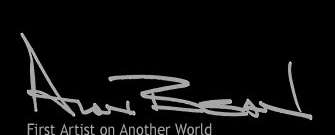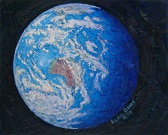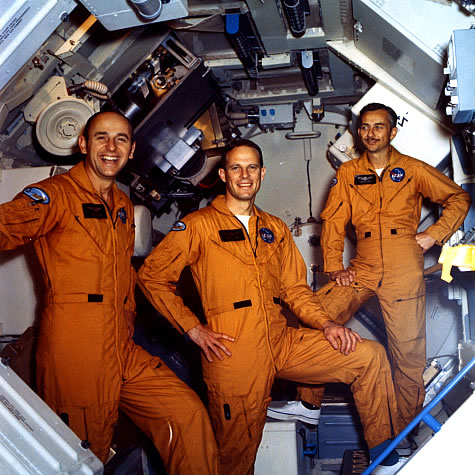
|
Godspeed, Alan Bean March 15, 1932 - May 26, 2018 
|

|
- Home
- Art of Another World
- Galleries
- Moonwalker & Astronaut
- About Alan Bean
- Available Paintings

|
Owen, Jack and I Were a Happy Crew
Jack Lousma in the center, Owen Garriott on the right and I are in the Skylab mockup
training for our 56-day mission to America's first space station. We were scheduled to
launch in July of 1973 after training for over two years. We learned
all we needed to know about living for two months in space and operating all the equipment
and experiments aboard Skylab.
|
|
All photos courtesy of NASA.           
Jack, Owen and I are in that little cone-shaped command module on top of the Saturn 1B rocket, headed up to rendezvous with the orbiting Skylab space station. The Skylab 2 crew--Pete Conrad, Joe Kerwin and Paul Weitz--had returned a few weeks earlier from their 28-day stay and we had learned a lot from them about what our life would be like orbiting 260 miles above the Earth for two months. We were all looking forward to a great adventure. We Had a Thruster Quad Failure and Still Managed to Get There Here we are on our final approach to Skylab. We can see the workshop, with its single solar panel extending out to the left, orbiting high above the Amazon River way down there on planet Earth. Above the workshop, where Jack, Owen and I were going to spend most of our time for the next 56 days, is the Apollo telescope mount with its four solar panels facing the sun. The dark circular area closest to us is the port where we planned to dock our command module. The Tests We Did Here Helped NASA Build a Better Manned Maneuvering Unit for the Future One of the benefits of constructing the workshop inside the 3rd stage of the Saturn V rocket that launched the Skylab space station, was the large volume that became available. Within this spacious interior, I could evaluate a variety of control and stablization systems for future astronaut maneuvering units in a safe environment. Engineers could then design these maneuvering units so that they would perform effectively and reliably when we used them outside the safety of space stations or space ships. Owen Recorded This Beautiful Solar Flare One of the most important experiments we had aboard Skylab was the Apollo telescope mount. It was a group of six separate intruments designed to look at the sun and see things that couldn't be seen from Earth because of our atmosphere. This is an image of the sun taken by the Naval Reserch Laboraratory spectroheliograph. Going Outside a Spaceship in Earth Orbit is Scarier Than Walking on the Moon Here I am in my spacesuit, floating outside of Skylab. I am 260 miles up, traveling 18,000 miles per hour. I can see many places on Earth that are only familiar to me from maps in my geography books in high school. I look to the left and see the Nile River all the way into Africa as far as the Aswan Dam. It is about the size of a pinhead but looks exactly like a miniscule dam. I look the other way and I can see Sicily and the whole boot of Italy headed up into Europe. It feels like I am on the front of a 747 moving across the world. We Needed to Carry out Routine Maintenance Every Day to Keep Skylab a Great Place to Live We had to perform a number of chores each day to keep our home in space functioning smoothly, just like we have to do tasks on Earth to keep our homes habitable. Here, I am putting chemicals in a potable water tank so that the water inside would remain healthy for us to drink over the next several weeks. I am holding onto the end of that tank with my right hand so I will remain in position to service the tank with my left. Living in zero gravity is a lot of fun, but when I wanted to do useful work I had to stabilize myself with a handhold or foothold. We Had a Lot of Fun at Mealtime Owen, Jack and I are having some fun around the dinner table in the ward room. In zero gravity, eating and swallowing are just as effective no matter what position your body is in. One day at lunch I observed Owen's and Jack's shirts were spotted with food and mine was still nice and clean, so I began to kid them about it. They each started looking closely at their shirts and at about the same time they said "Wait a minute, Al. Most of these food spots are chili and you are the only one of our crew that eats chili." We all thought about it for a few seconds, and then started laughing, because we realized that in zero gravity, if you are a messy eater, your shirt doesn't get dirty, the other guys' shirt does. We Evaluated a Lot of Tasks That Would be Required on Even Longer Missions We were only going to be up in Skylab for about 2 months, so we each could easily have gone without a haircut. One of our goals, however, since our mission would be the longest time American astronauts had spent in space to that date, was to evaluate all the things that we would need to do to live in space for even longer periods. Owen is giving me a haircut and we definitely do not want all those little hairs floating around in the air and getting in our eyes, noses and mouths. The vacuum hose was able to do that job effectively, preventing any future problems. We Did Not Work All the Time I was a wanna-be gymnast and diver in college but I wasn't very good at either. However, inside the workshop, in zero G, I was able to do spins, twists and other tumbling and diving acrobatics that even Olympic athletes back on Earth couldn't do. I did a lot of these for fun in the first week or two, and not so many after that. Near the end of our mission, I thought "You know, I'll never get a chance to be this great an athlete again," so I did a bunch more before we headed back to Earth. Our Earth is the Most Beautiful Place to Live our One Life It was a beautiful day when Owen, Jack and I splashed down in the Pacific Ocean several hundred miles southwest of San Diego. The frogmen arrived a short time later by helicopter and attached an orange floatation collar around our command module. I remember telling Owen and Jack that I was real proud of the fact that we had given everything we had to give for the last 59 days. We had done as much as it was humanly possible for us to do, to make our mission a success. We found out later we had accomplished 150% of our pre-mission predicted goals. I think I am more proud of our effort than anything I accomplished in my 18 years as an astronaut. |
Home |
Art of Another World |
Galleries |
Moonwalker & Astronaut |
About Alan Bean |
Available Paintings |
About this Site
Copyright © 2008-2025 by Alan Bean. All rights reserved.
Copyright © 2008-2025 by Alan Bean. All rights reserved.
